Fufu Yu
Rethinking Clothes Changing Person ReID: Conflicts, Synthesis, and Optimization
Apr 19, 2024Abstract:Clothes-changing person re-identification (CC-ReID) aims to retrieve images of the same person wearing different outfits. Mainstream researches focus on designing advanced model structures and strategies to capture identity information independent of clothing. However, the same-clothes discrimination as the standard ReID learning objective in CC-ReID is persistently ignored in previous researches. In this study, we dive into the relationship between standard and clothes-changing~(CC) learning objectives, and bring the inner conflicts between these two objectives to the fore. We try to magnify the proportion of CC training pairs by supplementing high-fidelity clothes-varying synthesis, produced by our proposed Clothes-Changing Diffusion model. By incorporating the synthetic images into CC-ReID model training, we observe a significant improvement under CC protocol. However, such improvement sacrifices the performance under the standard protocol, caused by the inner conflict between standard and CC. For conflict mitigation, we decouple these objectives and re-formulate CC-ReID learning as a multi-objective optimization (MOO) problem. By effectively regularizing the gradient curvature across multiple objectives and introducing preference restrictions, our MOO solution surpasses the single-task training paradigm. Our framework is model-agnostic, and demonstrates superior performance under both CC and standard ReID protocols.
Generalizable Person Search on Open-world User-Generated Video Content
Oct 16, 2023Abstract:Person search is a challenging task that involves detecting and retrieving individuals from a large set of un-cropped scene images. Existing person search applications are mostly trained and deployed in the same-origin scenarios. However, collecting and annotating training samples for each scene is often difficult due to the limitation of resources and the labor cost. Moreover, large-scale intra-domain data for training are generally not legally available for common developers, due to the regulation of privacy and public security. Leveraging easily accessible large-scale User Generated Video Contents (\emph{i.e.} UGC videos) to train person search models can fit the open-world distribution, but still suffering a performance gap from the domain difference to surveillance scenes. In this work, we explore enhancing the out-of-domain generalization capabilities of person search models, and propose a generalizable framework on both feature-level and data-level generalization to facilitate downstream tasks in arbitrary scenarios. Specifically, we focus on learning domain-invariant representations for both detection and ReID by introducing a multi-task prototype-based domain-specific batch normalization, and a channel-wise ID-relevant feature decorrelation strategy. We also identify and address typical sources of noise in open-world training frames, including inaccurate bounding boxes, the omission of identity labels, and the absence of cross-camera data. Our framework achieves promising performance on two challenging person search benchmarks without using any human annotation or samples from the target domain.
SoccerNet 2023 Challenges Results
Sep 12, 2023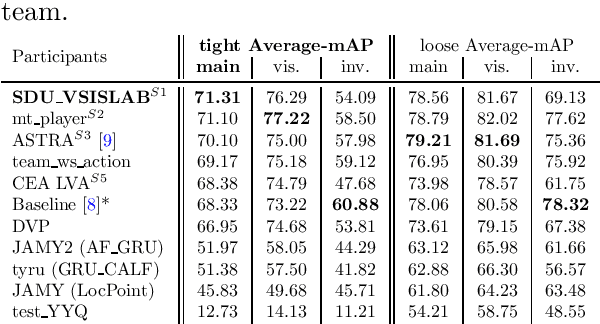


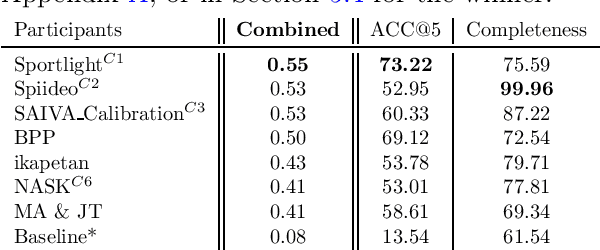
Abstract:The SoccerNet 2023 challenges were the third annual video understanding challenges organized by the SoccerNet team. For this third edition, the challenges were composed of seven vision-based tasks split into three main themes. The first theme, broadcast video understanding, is composed of three high-level tasks related to describing events occurring in the video broadcasts: (1) action spotting, focusing on retrieving all timestamps related to global actions in soccer, (2) ball action spotting, focusing on retrieving all timestamps related to the soccer ball change of state, and (3) dense video captioning, focusing on describing the broadcast with natural language and anchored timestamps. The second theme, field understanding, relates to the single task of (4) camera calibration, focusing on retrieving the intrinsic and extrinsic camera parameters from images. The third and last theme, player understanding, is composed of three low-level tasks related to extracting information about the players: (5) re-identification, focusing on retrieving the same players across multiple views, (6) multiple object tracking, focusing on tracking players and the ball through unedited video streams, and (7) jersey number recognition, focusing on recognizing the jersey number of players from tracklets. Compared to the previous editions of the SoccerNet challenges, tasks (2-3-7) are novel, including new annotations and data, task (4) was enhanced with more data and annotations, and task (6) now focuses on end-to-end approaches. More information on the tasks, challenges, and leaderboards are available on https://www.soccer-net.org. Baselines and development kits can be found on https://github.com/SoccerNet.
Exploiting the Textual Potential from Vision-Language Pre-training for Text-based Person Search
Mar 08, 2023Abstract:Text-based Person Search (TPS), is targeted on retrieving pedestrians to match text descriptions instead of query images. Recent Vision-Language Pre-training (VLP) models can bring transferable knowledge to downstream TPS tasks, resulting in more efficient performance gains. However, existing TPS methods improved by VLP only utilize pre-trained visual encoders, neglecting the corresponding textual representation and breaking the significant modality alignment learned from large-scale pre-training. In this paper, we explore the full utilization of textual potential from VLP in TPS tasks. We build on the proposed VLP-TPS baseline model, which is the first TPS model with both pre-trained modalities. We propose the Multi-Integrity Description Constraints (MIDC) to enhance the robustness of the textual modality by incorporating different components of fine-grained corpus during training. Inspired by the prompt approach for zero-shot classification with VLP models, we propose the Dynamic Attribute Prompt (DAP) to provide a unified corpus of fine-grained attributes as language hints for the image modality. Extensive experiments show that our proposed TPS framework achieves state-of-the-art performance, exceeding the previous best method by a margin.
SoccerNet 2022 Challenges Results
Oct 05, 2022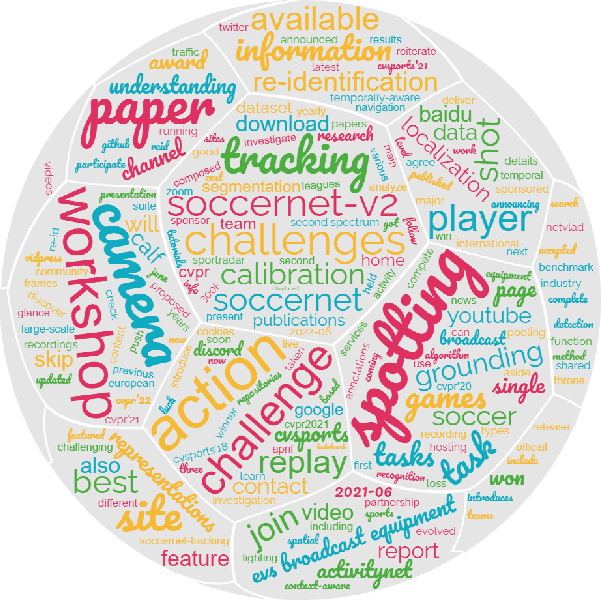



Abstract:The SoccerNet 2022 challenges were the second annual video understanding challenges organized by the SoccerNet team. In 2022, the challenges were composed of 6 vision-based tasks: (1) action spotting, focusing on retrieving action timestamps in long untrimmed videos, (2) replay grounding, focusing on retrieving the live moment of an action shown in a replay, (3) pitch localization, focusing on detecting line and goal part elements, (4) camera calibration, dedicated to retrieving the intrinsic and extrinsic camera parameters, (5) player re-identification, focusing on retrieving the same players across multiple views, and (6) multiple object tracking, focusing on tracking players and the ball through unedited video streams. Compared to last year's challenges, tasks (1-2) had their evaluation metrics redefined to consider tighter temporal accuracies, and tasks (3-6) were novel, including their underlying data and annotations. More information on the tasks, challenges and leaderboards are available on https://www.soccer-net.org. Baselines and development kits are available on https://github.com/SoccerNet.
Domain Adaptive Person Search
Jul 25, 2022



Abstract:Person search is a challenging task which aims to achieve joint pedestrian detection and person re-identification (ReID). Previous works have made significant advances under fully and weakly supervised settings. However, existing methods ignore the generalization ability of the person search models. In this paper, we take a further step and present Domain Adaptive Person Search (DAPS), which aims to generalize the model from a labeled source domain to the unlabeled target domain. Two major challenges arises under this new setting: one is how to simultaneously solve the domain misalignment issue for both detection and Re-ID tasks, and the other is how to train the ReID subtask without reliable detection results on the target domain. To address these challenges, we propose a strong baseline framework with two dedicated designs. 1) We design a domain alignment module including image-level and task-sensitive instance-level alignments, to minimize the domain discrepancy. 2) We take full advantage of the unlabeled data with a dynamic clustering strategy, and employ pseudo bounding boxes to support ReID and detection training on the target domain. With the above designs, our framework achieves 34.7% in mAP and 80.6% in top-1 on PRW dataset, surpassing the direct transferring baseline by a large margin. Surprisingly, the performance of our unsupervised DAPS model even surpasses some of the fully and weakly supervised methods. The code is available at https://github.com/caposerenity/DAPS.
Solution for Large-scale Long-tailed Recognition with Noisy Labels
Jun 20, 2021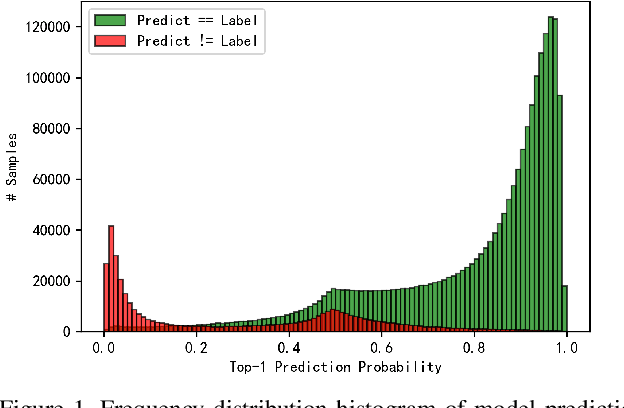
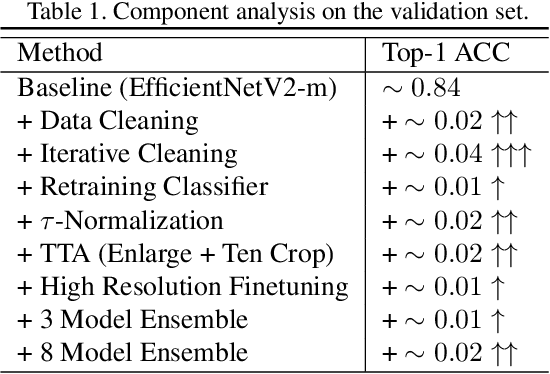
Abstract:This is a technical report for CVPR 2021 AliProducts Challenge. AliProducts Challenge is a competition proposed for studying the large-scale and fine-grained commodity image recognition problem encountered by worldleading ecommerce companies. The large-scale product recognition simultaneously meets the challenge of noisy annotations, imbalanced (long-tailed) data distribution and fine-grained classification. In our solution, we adopt stateof-the-art model architectures of both CNNs and Transformer, including ResNeSt, EfficientNetV2, and DeiT. We found that iterative data cleaning, classifier weight normalization, high-resolution finetuning, and test time augmentation are key components to improve the performance of training with the noisy and imbalanced dataset. Finally, we obtain 6.4365% mean class error rate in the leaderboard with our ensemble model.
* 3 pages
One for More: Selecting Generalizable Samples for Generalizable ReID Model
Dec 11, 2020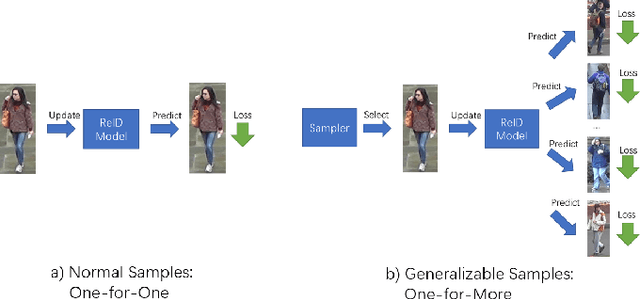

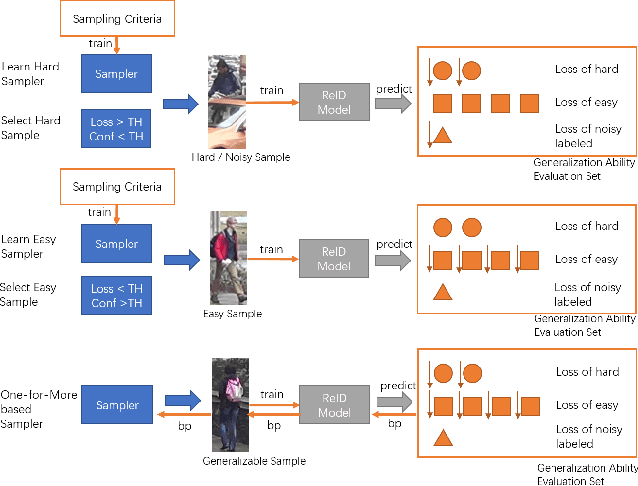
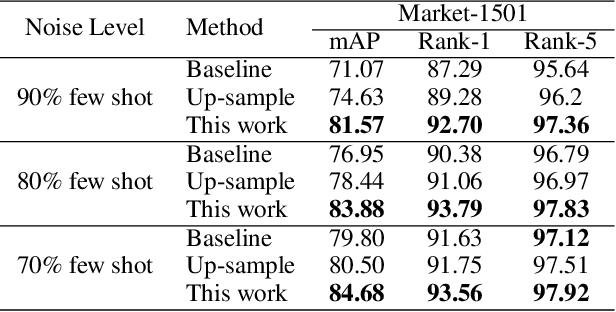
Abstract:Current training objectives of existing person Re-IDentification (ReID) models only ensure that the loss of the model decreases on selected training batch, with no regards to the performance on samples outside the batch. It will inevitably cause the model to over-fit the data in the dominant position (e.g., head data in imbalanced class, easy samples or noisy samples). %We call the sample that updates the model towards generalizing on more data a generalizable sample. The latest resampling methods address the issue by designing specific criterion to select specific samples that trains the model generalize more on certain type of data (e.g., hard samples, tail data), which is not adaptive to the inconsistent real world ReID data distributions. Therefore, instead of simply presuming on what samples are generalizable, this paper proposes a one-for-more training objective that directly takes the generalization ability of selected samples as a loss function and learn a sampler to automatically select generalizable samples. More importantly, our proposed one-for-more based sampler can be seamlessly integrated into the ReID training framework which is able to simultaneously train ReID models and the sampler in an end-to-end fashion. The experimental results show that our method can effectively improve the ReID model training and boost the performance of ReID models.
Devil's in the Detail: Graph-based Key-point Alignment and Embedding for Person Re-ID
Sep 11, 2020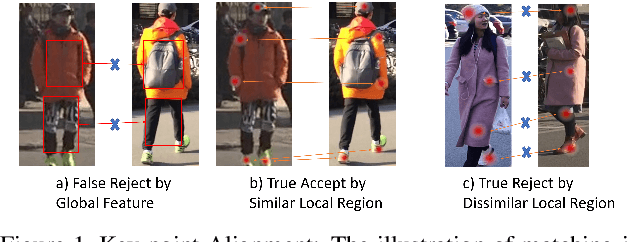

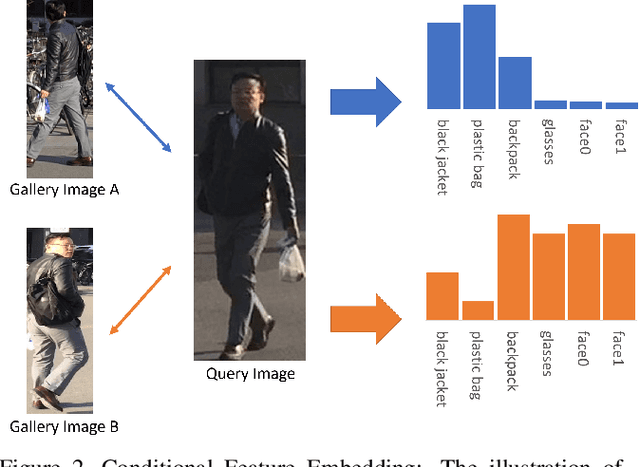

Abstract:Although Person Re-Identification has made impressive progress, difficult cases like occlusion, change of view-point and similar clothing still bring great challenges. Besides overall visual features, matching and comparing detailed local information is also essential for tackling these challenges. This paper proposes two key recognition patterns to better utilize the local information of pedestrian images. From the spatial perspective, the model should be able to select and align key-points from the image pairs for comparison (i.e. key-points alignment). From the perspective of feature channels, the feature of a query image should be dynamically adjusted based on the gallery image it needs to match (i.e. conditional feature embedding). Most of the existing methods are unable to satisfy both key-point alignment and conditional feature embedding. By introducing novel techniques including correspondence attention module and discrepancy-based GCN, we propose an end-to-end ReID method that integrates both patterns into a unified framework, called Siamese-GCN. The experiments show that Siamese-GCN achieves state-of-the-art performance on three public datasets.
 Add to Chrome
Add to Chrome Add to Firefox
Add to Firefox Add to Edge
Add to Edge